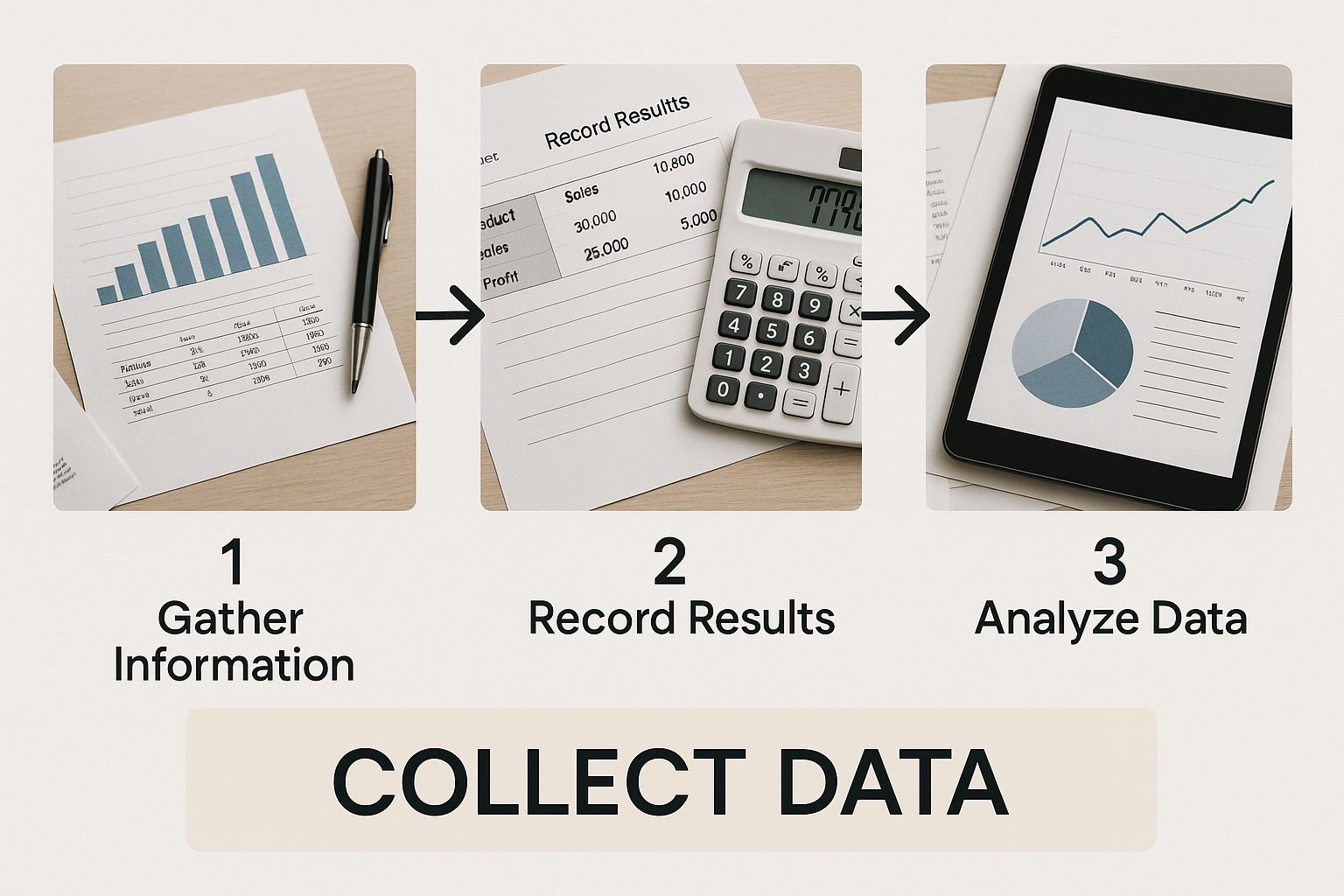A brand audit is so much more than a to-do list. It’s a full-on strategic deep dive into how your company is really doing in the market and, just as importantly, how your customers perceive you.
Think of it as a comprehensive health check for your brand, designed to uncover its strengths, pinpoint its weaknesses, and spot genuine opportunities for growth.
Why Your Brand Audit Is More Than a Checklist

Let's be honest—a lot of businesses treat a brand audit like just another marketing task. They'll check a few boxes for logo consistency, glance at their social media posts, and call it a day. But that surface-level approach completely misses the point.
A real brand audit is a powerful diagnostic tool. It’s your best shot at understanding what your customers, your employees, and the market truly think about you. This is where you uncover those hidden growth opportunities and finally figure out what's been holding you back.
It’s about asking the tough, necessary questions:
- Is our brand message still connecting with the people we want to reach?
- How do customers actually feel when they interact with us?
- Are we losing ground to our competitors? And if so, why?
The Core of Your Brand Is Trust
At the end of the day, a brand audit is really a measure of trust. In a crowded market, trust is the currency that drives loyalty and every single buying decision. It’s not just a nice-to-have.
In fact, recent studies show that 71% of global consumers say their trust in a brand is a 'buy or boycott' factor. That trust directly influences up to 81% of purchase decisions. That’s huge. It makes regularly checking in on your brand's health absolutely essential if you want to stay relevant.
A brand audit isn’t about finding what’s wrong. It’s about discovering what’s possible. It’s an honest conversation with your business, using data as the mediator. That clarity is what separates stagnant brands from the ones that consistently grow.
While a full audit covers your entire brand identity, from internal culture to your external marketing, you can definitely use more focused tools for specific areas. For example, a comprehensive website audit checklist is a great way to systematically review your digital presence, which is a massive part of your brand's public face.
For smaller businesses, knowing how to apply these insights is everything. Most of the really effective branding services for small businesses will start with this kind of foundational audit to make sure they’re building a strong, resonant brand right from the very beginning.
Alright, let's ditch the robotic tone and give this section a human touch.
Setting the Stage for an Effective Audit
Jumping into a brand audit without a clear plan is like starting a road trip without a map. Sure, you might stumble upon something interesting, but you’re probably not going to get where you need to go. A little prep work upfront makes all the difference.
First things first: you need to know your "why." What's the real reason you're doing this? Are you trying to figure out why sales have slumped? Getting ready for a massive rebrand? Or maybe you're just trying to understand how that new competitor is stealing your thunder. Your goals are the North Star for this whole process.
Define Your Audit Goals
And I mean specific goals. "Improve our brand" is way too vague—it's a wish, not an objective. You can't measure it, so you'll never know if you've succeeded.
Let's get concrete. Think more along these lines:
- Goal: Find out exactly why we've seen a 15% drop in customer retention over the last six months.
- Goal: Figure out if our brand is actually ready for an expansion into the European market.
- Goal: Hunt down every inconsistency in our brand voice across all our channels before we kick off the website redesign.
See the difference? Clear goals like these keep you focused. They ensure you're digging for the right data instead of just drowning in a sea of irrelevant numbers.
An audit’s success isn't measured by the amount of data you collect, but by the clarity of the answers you find. Set your questions first, and the data will follow.
Build Your Audit Framework
Once you know what you're trying to achieve, it's time to build your framework. This isn't some generic checklist you download off the internet. It’s your custom-built game plan, tailored specifically to the goals you just set. It should outline exactly what you'll analyze, who needs to be involved, and the tools you'll need to get the job done.
A solid framework is your best friend for structuring the investigation. To make it easier, I always suggest starting with a simple table to organize the core components you'll be looking at.
Core Components of a Brand Audit Framework
This table breaks down the essential areas to investigate during your brand audit, helping you build out a comprehensive checklist so nothing falls through the cracks.
| Audit Area | What to Analyze | Example Metrics |
|---|---|---|
| Internal Branding | Company culture, mission alignment, employee perception | Employee Net Promoter Score (eNPS), internal survey results |
| External Branding | Logo, messaging, website, social media presence | Brand recall scores, social media engagement rates, website traffic |
| Customer Experience | Sales process, customer support, post-purchase follow-up | Customer Satisfaction (CSAT) scores, Net Promoter Score (NPS) |
Putting this structure in place helps you cover all your bases without getting lost in the weeds. It also forces you to think about a realistic budget and timeline. Brand audits can be intense, so getting buy-in from key people is a must. I recommend pulling together a small, cross-functional team—someone from marketing, sales, and customer service—to get a truly holistic view of the brand.
This whole planning process is a critical first step. The insights you uncover here will directly shape your brand's future. For a deeper look at what comes next, check out our guide on how to build a brand strategy. It’s the perfect follow-up once your audit is done.
Gathering Your Internal and External Brand Data
Okay, you've got your goals and framework sorted. Now comes the real work—the discovery phase. This is where you roll up your sleeves and start gathering the raw materials for your audit. Think of yourself as a detective, collecting the data, stories, and metrics that will form the bedrock of your analysis.
We'll tackle this in two streams.
First, we’ll look inward at your internal branding. This is all about your company culture, mission, and values. Are they actually alive and kicking within your team, or are they just some nice words on a poster in the breakroom?
Then, we'll turn our focus outward to your external branding. This covers everything a customer sees, touches, and feels—from your website and social media down to the packaging they unbox.
This image gives you a solid visual for how to organize your efforts as you start pulling all this information together.

As you can see, the key is to be systematic. You need to pull from a wide range of sources to get a complete, honest picture of where your brand stands right now.
Evaluating Your Internal Brand Health
Your internal brand is the soul of your company. It’s how your people experience your mission and values every single day. If there’s a gap between what you say and what you do internally, you can bet it will eventually leak out and affect your customer experience.
To get a real, unfiltered read on this, you have to go beyond the official company line. Employee surveys are a fantastic way to do this. Use them to ask direct questions about how your team perceives the brand, whether they truly understand the company's mission, and how they’d describe the culture to a friend.
Here are a few key areas to dig into:
- Mission Alignment: Do your employees actually get what the company is trying to achieve? Do they feel connected to it?
- Value Embodiment: Do they see leadership and daily operations reflecting the company's stated values? Or is it a case of "do as I say, not as I do"?
- Brand Advocacy: How likely are they to recommend your company as a great place to work? This is your eNPS, or Employee Net Promoter Score, and it’s a powerful metric.
A quick but important tip: anonymity is everything here. You want the truth, not just what people think management wants to hear. This internal perspective is a goldmine for figuring out if you're practicing what you preach. This is especially critical for new companies, something we cover more in our post on developing a branding strategy for startups.
Analyzing Your External Brand Touchpoints
If your internal brand is the heart, then your external brand is the face you show the world. A proper brand audit digs deep into this public-facing identity to see how you stack up in the market.
Consider that 55% of first impressions are visual. That means consistency across all your marketing materials isn't just a "nice-to-have"—it's non-negotiable. And with 77% of consumers saying they prefer to buy from brands they follow on social media, your digital presence has to be on point.
Your brand isn't what you say it is. It's what Google says it is. And more importantly, it's what your customers tell their friends it is.
To get a full 360-degree view, you need to collect data from every single place a customer might interact with you. This isn't just about numbers; it's a mix of quantitative data (the what) and qualitative feedback (the why).
This means firing up Google Analytics to check on website performance, bounce rates, and user flow. It also means diving into your social media analytics to review engagement, audience demographics, and what content is actually resonating. Combining this hard data with the human element gives you a much richer, more actionable story.
Analyzing Your Competitors and Market Position
Let's be real: your brand doesn’t exist in a vacuum. To truly understand where you stand, you have to take an honest look at your competitors. The point isn’t to copy their every move, but to find what makes you different and carve out your own space.
This part of the audit is all about competitive intelligence. You’re aiming to benchmark your own performance, spot the opportunities everyone else is missing, and sharpen the message that sets you apart.
Identifying Your True Competitors
First things first, you need a clear picture of who you're actually up against. It's easy to list your direct competitors—the ones offering a nearly identical product or service. But don’t stop there.
You also need to think about your partial or indirect competitors. These are the businesses that solve the same customer problem, just with a different solution. If you run a local coffee shop, your competition isn't just the café across the street. It might be the high-end grocery store with a fancy coffee bar or even a popular energy drink brand that people grab instead of a latte.
Competitive analysis isn't about creating a list of enemies. It's about defining the context in which your customers make choices. You need to understand all the options they are considering, not just the ones that look like you.
Once you have your list, pick three to five direct competitors to really dig into. This gives you enough data to spot meaningful patterns without getting totally overwhelmed. As you start digging in, doing a comprehensive SEO competitor analysis is a great way to see how your rivals are winning (or losing) online.
What to Analyze in Your Competitors
Alright, time to put on your detective hat. This goes way beyond a quick glance at their homepage. You need to look at their brand from every possible angle.
Here’s what to look for:
- Messaging and Positioning: What’s their core value proposition? How do they talk about themselves, and what key benefits do they hammer home in their marketing?
- Visual Identity: Take a close look at their logo, color palette, and overall design style. Does it feel modern or traditional? Playful or corporate? How does it stack up against your own?
- Customer Sentiment: Dive into their social media comments, online reviews, and forum discussions. What do customers absolutely love about them? And what are the common complaints?
- Content and Social Media: What topics are they covering on their blog or social feeds? Which posts get the most engagement? This is a goldmine for understanding what their audience actually cares about.
This whole process is about finding the gaps. If every single one of your competitors is screaming about affordability, there might be a massive opportunity to position your brand around premium quality or an unforgettable customer experience.
This broader understanding of the market is absolutely crucial for growth. The numbers don't lie: 57% of consumers say they prefer buying from brands they feel connected to, even if a competitor is cheaper. The tech industry alone, where brand audits are standard practice, accounts for $1.3 trillion in brand value—proving just how much a well-defined brand can be worth.
Turning Your Audit Findings Into an Action Plan

Okay, you've done the heavy lifting. You've gathered a mountain of data, chatted with your team, and sized up the competition. Now what? All that information is just noise until you shape it into a clear, strategic game plan. This is where your brand audit truly proves its worth—turning those raw findings into concrete actions.
You're probably looking at dozens of data points, from customer feedback to social media metrics. The first job is to cut through the static and spot the patterns.
Synthesizing Your Data with a SWOT Analysis
The classic SWOT analysis (Strengths, Weaknesses, Opportunities, Threats) is your best friend here. It’s a simple but powerful framework that forces you to categorize everything in a way that naturally points to your next move. Don't just make lists; tie every point back to the real data you collected.
- Strengths: What did the audit show you're nailing? Maybe your customer service gets rave reviews, or your internal culture is a secret weapon.
- Weaknesses: Where are the recurring pain points? This could be anything from inconsistent messaging across your marketing to a clunky user experience on your website.
- Opportunities: What gaps in the market are you perfectly positioned to fill? Maybe your competitors are completely ignoring a customer segment you could connect with.
- Threats: What’s happening out there that could throw a wrench in your plans? Think new competitors, a shift in public opinion, or changing consumer habits.
Laying it all out this way transforms that pile of data into a strategic map. Your weaknesses become a clear to-do list, and your strengths show you what to double down on. This synthesis is the foundation for building a strong brand that can actually adapt and grow.
A brand audit report shouldn't just be a summary of what you found. It needs to be a persuasive argument for what you must do next. It has to tell a clear story that connects the dots from the data to your proposed solutions.
Prioritizing Your Recommendations
That SWOT analysis probably just handed you a massive to-do list. You can’t do it all at once. The next step is all about prioritization.
A super effective way to do this is to score each potential action on two simple things: impact and feasibility.
Just create a simple matrix. Plot each idea based on how much it will move the needle on your goals and how easy (or hard) it will be to pull off. This visual makes it incredibly easy to spot the "quick wins"—those high-impact, low-effort tasks you should jump on right away. It also helps you budget time and resources for the bigger, more involved projects down the line.
Building Your Final Audit Report
Your final report is your pitch to get everyone on board. It needs to be clear, direct, and convincing. Start with an executive summary of the big takeaways, then dive into your detailed action plan.
For every single recommendation, you need to include:
- The Specific Action: What, exactly, needs to be done? (e.g., "Redesign the customer onboarding email sequence.")
- Ownership: Who is leading the charge? Putting a name on it creates real accountability.
- Measurable Goals: How will you know if it worked? (e.g., "Increase new user engagement by 20% within three months.")
- Timeline: When does this need to be done?
Sometimes, the audit might reveal that you need a major strategic shift, maybe even a full rebrand. If you find yourself in that boat, check out these iconic rebranding examples and strategies for some inspiration. It helps to see how other companies have navigated big changes.
Ultimately, a well-structured action plan is what makes your brand audit a real catalyst for meaningful, measurable growth.
Your Top Brand Audit Questions, Answered
Even with a solid plan, it's totally normal to have a few questions rattling around before you kick off a brand audit. Let's get into some of the most common ones I hear. My goal is to clear things up so you can jump in with confidence and see it through.
One of the first things that always comes up is timing. When and how often should you actually do this? Well, it really depends on what's happening with your business right now.
How Often Should We Do a Brand Audit?
For a full, top-to-bottom brand audit, aiming for every one to two years is a great rhythm. Think of it as a strategic health check-up for your brand. But you definitely don't want to wait that long if your business is going through a major change.
You’ll want to run an audit much sooner if you’re staring down things like:
- A merger or acquisition that's about to shake up your company.
- Pushing into a totally new market or launching a big, shiny new product.
- Seeing a consistent, worrying dip in sales, engagement, or customer love.
For the in-between times, smaller "mini-audits" are your best friend. You can run these quarterly on specific things, like your social media vibe or how your website is performing. They’re like regular maintenance, keeping your brand sharp and tuned in to what the market is doing.
Can a Small Business Run an Audit Without a Big Budget?
Yes! A thousand times, yes. You absolutely do not need to shell out for a pricey agency to get incredible insights. A small business can pull off a powerful DIY brand audit just by being smart and focusing on what really moves the needle.
The fundamental process is the same; you’re just scaling it to your resources. There are so many fantastic free tools out there. Google Analytics, the analytics built right into your social media platforms, and free survey tools like Google Forms are perfect for grabbing customer feedback and key metrics. The secret is to pour your energy into the high-impact zones, like your customer experience and how you show up online locally.
Negative feedback isn't a failure—it's a gift. It's unfiltered, honest data telling you exactly where to direct your energy for the most meaningful improvements.
What if We Uncover a Lot of Negative Feedback?
Honestly? Finding a pile of negative feedback is a win. It’s a bright, flashing arrow pointing directly at what you need to fix. The first, most crucial step is just to listen. Don't get defensive.
Start grouping the feedback into themes. Is the problem really about your product quality? Is it your customer service team taking too long to reply? Or is your brand's messaging just not landing right? Use these themes to build out a priority list. For a more structured gut-check, a good brand identity checklist can help make sure you’re covering all your bases.
Be open with your team about what you found and map out a game plan together. This kind of raw, honest feedback is often the spark for the most powerful and positive changes a brand can ever make.
At Creativize, we believe that a strong brand is built on understanding and connection. Our platform helps you find the local creative talent you need to turn your audit findings into powerful, professional branding that truly resonates. Find the perfect creative partner on Creativize.

